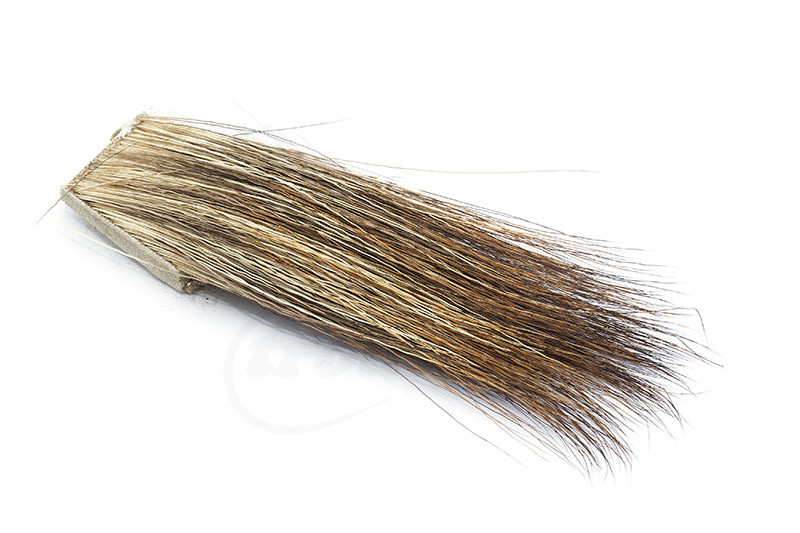Moose mane hair is a unique and valuable material in fly tying, known for its distinctive properties and versatility. Here’s an overview of its characteristics, uses, and tips for tying with moose mane hair.
Moose Mane Details and Characteristics:
- Length and Diameter: Moose mane hair is typically long and fine, with individual hairs often reaching several inches in length. This makes it suitable for creating longer body segments or tails.
- Color: Natural moose mane hair is usually black or dark brown, with some lighter brown or tan hairs. These contrasting colors are beneficial for creating realistic segmentation on fly bodies.
- Strength: Despite its fine diameter, moose mane hair is quite strong and durable. It resists breaking and holds up well in the water.
- Flexibility: Moose mane hair is relatively stiff compared to other natural hairs, which helps in maintaining shape and structure when tied onto a hook.
Uses in Fly Tying
- Dry Fly Bodies: Moose mane hair is often used to create segmented bodies on dry flies, such as mayflies and stoneflies. The contrasting colors can be used to create realistic-looking segments without additional materials.
- Tails: Its stiffness makes it an excellent material for tails on dry flies, where a rigid, straight tail is desirable.
- Ant and Beetle Patterns: The fine, segmented appearance of moose mane hair is perfect for tying ant and beetle patterns, mimicking the segmented bodies of these insects.
- Nymphs: Although less common, moose mane hair can be used in nymph patterns, particularly for creating ribbing or accentuating body segments.
- Spinners: For spinner patterns, where a realistic body profile is essential, moose mane hair excels due to its natural segmentation and strength.
Tips for Tying with Moose Mane Hair
- Preparation: Before tying, select hairs of the desired length and color. Clean the hair to remove any dirt or debris.
- Segmentation: To achieve a segmented look, alternate between dark and light hairs or wrap the hair in a way that creates visible segments. You can also combine moose mane with other materials like thread or wire for added segmentation.
- Tying Technique: Moose mane hair can be tied in using standard techniques. When creating bodies, tie the hair at the hook bend and wrap it forward, securing it with thread wraps.
- Combining with Other Materials: Moose mane hair works well in combination with other materials. For example, you can use it with dubbing to create a textured, segmented body.
- Storing: Store moose mane hair in a cool, dry place to maintain its condition. Avoid compressing it to prevent bends or kinks in the hair.
Popular Patterns Using Moose Mane Hair
- Mosquito: The mosquito fly pattern often uses moose mane for the body to mimic the segmented abdomen of a real mosquito.
- Humpy: The Humpy dry fly uses moose mane for the tail and body, creating a buoyant and highly visible fly.
- Moose Mane Midge: This midge pattern utilizes moose mane for a segmented body, perfect for imitating small chironomids.
Moose mane hair is a versatile and effective material in fly tying, providing unique advantages for creating realistic and durable fly patterns.



